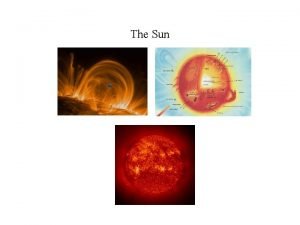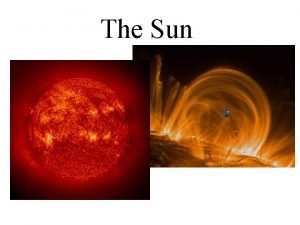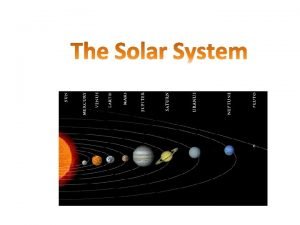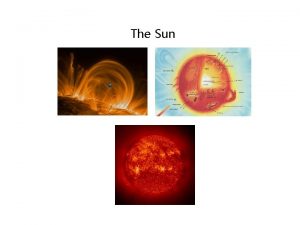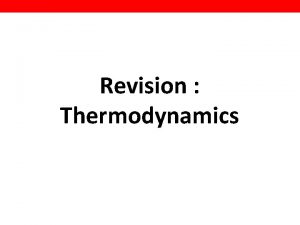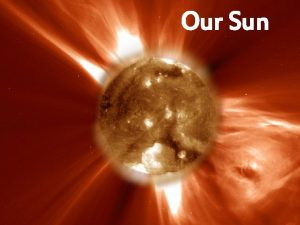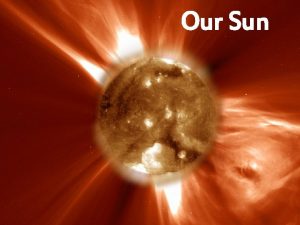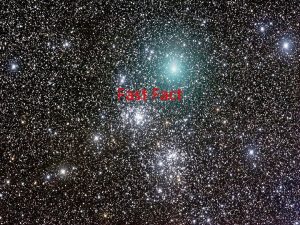The Sun Sun Fact Sheet The Sun is















- Slides: 15

The Sun

Sun Fact Sheet The Sun is a normal G 2 star, one of more than 100 billion stars in our galaxy. Diameter: 1, 390, 000 km (Earth 12, 742 km or nearly 100 times smaller) Mass: 1. 1989 x 1030 kg (333, 000 times Earth’s mass) Temperature: 5800 K (surface) 15, 600, 000 K (core) The Sun contains more than 99. 8% of the total mass of the Solar System (Jupiter contains most of the rest). Chemical composition: Hydrogen 92. 1% Helium 7. 8% Rest of the other 90 naturally occurring elements: 0. 1%

The Sun and its Planets to Scale

Energy is created in the core when hydrogen is fused to helium. This energy flows out from the core by radiation through the radiative layer, by convection through the convective layer, and by radiation from the surface of the photosphere, which is the portion of the Sun we see.

The seasons occur because the tilt of the Earth's axis keeps a constant orientation as the Earth revolves around the Sun. A. Summer in northern hemisphere. B. Winter in southern hemisphere

Sun’s Magnetic Field The Sun's corona is threaded with a complex network of magnetic fields. Solar storms and flares result from changes in the structure and connections of these fields. When some of the Sun's magnetic field lines are filled with hot gas, we see a magnetic loop.

Sunspots appear as dark spots on the surface of the Sun. Temperatures in the dark centers of sunspots drop to about 3700 K (compared to 5700 K for the surrounding photosphere). They typically last for several days, although very large ones may live for several weeks.

Solar Prominences are dense clouds of material suspended above the surface of the Sun by loops of magnetic field. Prominences can remain in a quiet or quiescent state for days or weeks. However, as the magnetic loops that support them slowly change, prominences can erupt and rise off of the Sun over the course of a few minutes or hours

Solar Flares Solar flares are tremendous explosions on the surface of the Sun. In a matter of just a few minutes they heat material to many millions of degrees and release as much energy as a billion megatons of TNT. They occur near sunspots, usually along the dividing line (neutral line) between areas of oppositely directed magnetic fields. Images from SOHO* *NASA/ESA Solar and Heliospheric Observatory spacecraft

Corona and Solar Wind The Sun’s Corona is forever expanding into interplanetary space filling the solar system with a constant flow of solar wind. Solar wind is the continuous flow of charged particles (ions, electrons, and neutrons) that comes from the Sun in every direction. Solar wind consists of slow and fast components. Slow solar wind is a consequence of the corona’s high temperature. The speed of the solar wind varies from less than 300 km/s (about half a million miles per hour) to over 800 km/s.

Solar wind shapes the Earth's magnetosphere and magnetic storms are illustrated here as approaching Earth. These storms, which occur frequently, can disrupt communications and navigational equipment, damage satellites, and even cause blackouts. The white lines represent the solar wind; the purple line is the bow shock line; and the blue lines surrounding the Earth represent its protective magnetosphere.

Hertzsprung-Russell diagram of star luminosity versus surface temperatures. The vertical axis is a comparative one based on the Sun having a luminosity of 1. The horizontal axis is reversed from the normal order, with values of surface temperature increasing to the left. Note that the Sun is a middle-range, main-sequence star.


Thermonuclear fusion heats the inside of the star, creating pressure that stops the collapse and producing a long period of great stability that defines the main sequence.

Life Cycle of the Sun Birth: Gravitational Collapse of Interstellar Cloud "Hayashi Contraction" of Protostar Life: Stability on Main-Sequence Long life - energy from nuclear reactions in the core (E = mc 2) Death: Lack of fuel, instability, variability expansion (red giant, then white dwarf)
 The sun fact sheet
The sun fact sheet Sun fact sheet
Sun fact sheet Spectre fact sheet
Spectre fact sheet Old mutual absolute smooth growth portfolio fund fact sheet
Old mutual absolute smooth growth portfolio fund fact sheet Fafsa fact or myth sheet
Fafsa fact or myth sheet Bscl fact sheet
Bscl fact sheet Event fact sheet
Event fact sheet Ccc plus waiver manual
Ccc plus waiver manual Sun fact file
Sun fact file Stock verified
Stock verified Các môn thể thao bắt đầu bằng tiếng chạy
Các môn thể thao bắt đầu bằng tiếng chạy Sự nuôi và dạy con của hươu
Sự nuôi và dạy con của hươu điện thế nghỉ
điện thế nghỉ Nguyên nhân của sự mỏi cơ sinh 8
Nguyên nhân của sự mỏi cơ sinh 8 Một số thể thơ truyền thống
Một số thể thơ truyền thống Trời xanh đây là của chúng ta thể thơ
Trời xanh đây là của chúng ta thể thơ
